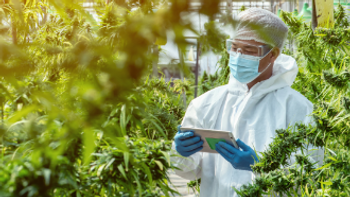
Cannabis Science and Technology
- September/October 2019
- Volume 2
- Issue 5
In Situ Fluorescence Spectroscopy for In-Line Distillation Process Monitoring
Fluorescence spectroscopy was investigated as an in-line process monitoring tool for cannabis distillation to alleviate the challenges of specialized personnel, high costs, and low yields.
Currently, cannabis distillation requires specialized personnel, which raises costs and lowers yields. Furthermore, process monitoring is dependent on indirect controls, such as temperature, flow, and color. Here, fluorescence spectroscopy was investigated as an in-line process monitoring tool for cannabis distillation to alleviate these challenges. First, excitation emission matrix spectroscopy (EEMS) was utilized to determine optimal excitation wavelengths for various stages of fractional distillation. Based on these results, a benchtop fluorometer that could use various excitation wavelengths was developed. Samples of extract, distillate, and pure laboratory grade cannabidiol (CBD), cannabidiolic acid (CBDA), delta-8 tetrahydrocannabinol (â8-THC), and delta-9-tetrahydrocannabinol (â9-THC) standards were measured with the benchtop system. The measurements from the extract and distillate samples exhibited several fluorescence peaks. These measurements depended on the processing conditions and product quality of the tested samples. Measurements of the chemical standards exhibited similar fluorescence to the extract and distillate samples. Finally, an in-line sensor was developed and installed on a short path distillation system (SPD). Measurement from the in-line sensor showed distinct differences between distillation fractions validating its capability as a cannabis distillation process monitoring tool.
The rising commercial interest in cannabis extract and distillate is increasing the need for more rapid and precise extraction and distillation methods. This need is especially critical for more precise dosing of compounds derived from cannabis for medical applications. While many common distillation methods exist (short path distillation, wiped film distillation, column separation, and so on) the techniques are highly technical and often can only be carried out by specialized personnel. This leads to lower production volumes and higher costs. To help reduce costs and increase purity of cannabis distillation, more precise and intuitive process control tools are needed.
Historically, fluorescence spectroscopy has been used for inline process control and quality control in several industries, including pharmaceuticals and food safety (1–8). Furthermore, studies on cannabinoids and their metabolites indicate that many of the compounds derived from cannabis will have unique spectroscopic properties, including fluorescing under ultraviolet (UV) light and Raman signal (9–15). While some literature exists, very little work has been published on using these unique optical properties to provide a process control system that can help improve product safety and purity.
Distillations of cannabis extract are carried out at temperatures reaching over 165 °C and under vacuum pressure. Vacuum distillation is utilized because desired cannabinoids chemically degrade into undesired compounds at temperatures below their boiling point under atmospheric pressure. This degradation is either decelerated greatly or completely halted under vacuum pressure.
The required vacuum pressure and temperature make the process of selecting and adding an in-line sensor challenging. The sensor must be robust enough to function under harsh conditions without creating undue risk of vacuum leaks during operation. This challenge is only exacerbated when considering a sensor that can be retrofitted onto existing distillation systems. Optical metrology methods are a promising approach for process control because they can probe processed material through a sight-glass or glass tube positioned away from the heat source. Specifically, fluorescence spectroscopy is a promising method to investigate the presence or absence of auto-fluorescing compounds within the distillate throughout the process.
In this work, fluorescence spectroscopy is investigated as a process monitoring technique for short path distillation (SPD).
Experimental
Excitation Emission Matrix Spectroscopy
A portable benchtop excitation emission matrix spectrometer (EEMS) was developed to determine the optimal excitation wavelength that could be used for monitoring fluorescence during the distillation of cannabinoids. Figure 1 shows the EEMS system used to investigate the approach.
For the excitation components of the instrument, the EEMS system used a Lambda LS Xenon Arc Lamp (Sutter Instrument) with a SPG-120-REV monochromator (Shimadzu). The sample holder was designed for a 1 cm x 1 cm quartz optical vial and was printed with a 3D printer (Zortrex M200). A USB 2000+ ultraviolet-visible (UV-vis) spectrometer (Ocean Optics) was set at a 90° angle with respect to the monochromated light source to collect fluorescence emission from the sample, and a STS-UV spectrometer (Ocean Optics) was placed directly across from the monochromated light source to measure the optical absorption of the sample.
For the measurements, 1 mL samples were collected from SPD of cannabinoids at three processing stages, colloquially referred to as heads, bodies, and tails. EEMS measurements were taken by first setting the monochromator to a specific wavelength. The resulting spectrum was then measured for both the fluorescence and absorption geometries. Next, the excitation wavelength was incrementally increased by 10 nm, and the process was repeated for excitation wavelengths from 300 nm to 800 nm.
Benchtop Fluorescence Spectrometer
After the EEMS system was used to determine the best wavelength for excitation, a benchtop fluorometer system (Arometrix) was used to measure fluorescence at a single excitation wavelength. Several configurations of the benchtop system were used to test the fluorescence response. Light sources at 340 nm, 365 nm, and 405 nm were used for the excitation wavelength and a spectrometer with a range from 340 nm to 780 nm was used as the detector. The device was enclosed in a housing that was dyed black to reduce any background fluorescence or reflections from the polymer housing of the sensor. Furthermore, the enclosure was designed to ensure that stray light from external sources did not enter the detector. Various optical edge filters were used in front of the detector to reduce the total excitation light intensity from reaching the detector and maximize the measured signal from the fluorescence.
The benchtop system was used to measure the fluorescence response of cannabis extract (NorCal Labs), distillate (NorCal Labs), and pure cannabinoids: â8-tetrahydrocannabinol (â8-THC), â9-tetrahydrocannabinol (â9-THC), and cannabidiol (CBD) (Cayman Chemical) as well as cannabidiolic acid (CBDA) (Sigma-Aldrich). The extract samples were synthesized from either hydrocarbon or ethanol extraction, and distillate samples were all synthesized via short path distillation. The extract and distillate samples that were tested in this work were not characterized with high performance liquid chromatography (HPLC), but the exact composition of these samples is not needed for the measurements performed in this study. These samples were tested to broadly investigate the diversity of the fluorescence response from different quality extract and distillate samples and to investigate any overall trends in these responses with respect to sample type. More rigorous studies on composition and fluorescence will be the focus of future work. Standard samples were 1 mg/mL solution of â8-THC in methanol, 1 mg/mL solution of â9-THC in methanol, 1 mg/mL solution CBDA in acetonitrile, and a 10 mg/mL solution of CBD in methanol.
For the extract and distillate, only the 365 nm excitation wavelength with no filter was investigated. The samples were diluted in ethanol at approximately 10:1 ratio of ethanol to product. The sample was then placed in a 1 cm x 1 cm polystyrene cuvette and the fluorescence measured.
For the HPLC standards, 2 mL â8-THC solution, 2 mL â9-THC solution, 1 mL CBDA solution, and 0.5 mL CBD solution were measured with the benchtop system. Three excitation wavelengths (340 nm, 365 nm, and 405 nm) were studied with 370 nm, 380 nm, 390 nm, and 420 nm edge filters (Edmond Scientific) as well as polycarbonate edge filters at thickness of 1/16-in., 3/32-in., and 5/64-in. (McMaster-Carr).
In-Line Fluorescence Spectrometer
An in-line configuration of the benchtop fluorometer was fabricated utilizing the same components from the original system but with a new form factor. Figure 2 shows a simplified schematic of an SPD system along the location of the fluorometer. During the distillation, approximately 3 L of hydrocarbon-extracted crude was distilled. The crude material was winterized and decarboxylated prior to the distillation. The device was placed on the tube directly after the condenser and immediately prior to the collection flask. The spectrometer detector was placed directly at the bottom of the tube and the light source was placed at a 90° angle from the spectrometer and aligned to the bottom of the tube. The alignment and relative placement of the light source to the spectrometer was designed such that the sensor was able to detect fluorescence at very low fill levels, which is a common case during SPD.
For acquisition, measurements were taken every 0.5 s. During each measurement two separate spectra were measured. The first spectrum was taken with no excitation light. The second spectrum was taken with excitation light. The spectrum taken without excitation light was used as a background to account for the signal from external light sources (overhead lighting, stray light, and so forth). The process was monitored during a complete SPD process.
Results and Discussion
Excitation Emission Matrix Spectroscopy
Figure 3 shows EEMS results from different fractions of an SPD process for the separation of â9-THC. The y-axis is the excitation wavelength used to induce fluorescence in the sample. The x-axis is the resulting emission spectra. Figures 3a and 3b show an EEMS spectra of a sample that was collected during the separation of high vapor pressure compounds, colloquially referred to as “heads.” The heads typically comprise latent solvents and a mixture of terpenes and degraded terpenes. Figure 3c shows an EEMS spectra of a sample that was collected from the separation of moderate vapor pressure compounds. This sample was taken under conditions that are ideal for the separation of cannabinoids, such as â9-THC or CBD, and is colloquially referred to as the “main body” or the “bodies” of the distillation. Figure 3d shows an EEMS spectra of a sample that was collected from the lowest vapor pressure compounds. This fraction, which generally consists of heavy waxes, paraffins, and colorants, is colloquially referred to as the “tails.” For the sake of clarity and brevity the samples from these measurements will be referred to as the corresponding distillation fraction, that is, “heads”, “bodies”, and “tails,” that the sample was collected from.
The heads EEMS spectra in Figure 3a shows two general regimes with fluorescent response, denoted as R1 and R2 in Figure 3. R1 appears between 350–450 nm with an excitation wavelength between 340 nm and 390 nm. R2 occurs between 450–540 nm with an excitation wavelength between 330 nm and 480 nm. A closer inspection of R2 shows that the region is made up of at least two separate fluorescent responses, as indicated by the multiple local maxima intensity value located in this region. These fluorescence responses are indicated with F1 and F2 in Figure 3b, with F1 centered at an excitation wavelength of 360–370 nm and a fluorescence wavelength of 470–490 nm and F2 centered at excitation source of 420–430 nm with a response at 500 nm. The fluorescence response in this sample was later identified to be due to the presence of both residual tails in the SPD system from the previous distillation as well as the beginning of the bodies fraction. A more detailed discussion of this analysis will be given in the section titled “In-line Fluorescence Spectrometer.”
The bodies EEMS spectra in Figure 3b shows that the shape and relative intensities of R1 and R2 between the heads and bodies samples were significantly different. In the bodies, R1 is induced by excitation wavelengths between 300 nm and 390 nm, extending 40 nm below R1 in the heads sample. Furthermore, the relative intensity of the entire R1 regime increased significantly when compared to the heads sample. R2 in the bodies was significantly contracted compared to R2 in the heads sample. Furthermore, F2 either does not exist in the bodies or has such a low response as to make it unresolvable. In contrast, F1 shows a much higher relative intensity in the bodies sample than the fluorescence response in the heads sample. The changes in R1 and R2 between the heads and bodies samples reflect a change in the chemicals that are eluting into the collection flask. This indicates that in-line fluorescence is a strong candidate for determining the transition between the heads and bodies of an SPD process.
The tails EEMS spectra in Figure 3d shows very stark differences in R1 and R2 when compared to the main body sample. The relative intensity of R1 in the tails sample is significantly diminished compared to R1 in the bodies sample. Conversely, the relative fluorescence in R2 of the tails sample has a significantly higher relative intensity in comparison to R2 of the bodies sample. This difference indicates that an in-line fluorescence system could detect the transition bodies and tails of an SPD process.
EEMS showed that fluorescence could be used to distinguish the changes between the investigated distillation fractions and showed that a 340–400 nm excitation wavelength fluorometer would be able to capture these transitions in-line. Based on this analysis, a fluorometer that could use a 340 nm, 365 nm, or 405 nm excitation wavelength was developed and the details of measurement results from this system are discussed in the next section.
Benchtop Fluorescence Spectrometer
Initial benchtop tests showed that the fluorescence response from extract and distillate varied greatly between processors, methods, and starting material. Figure 4 shows a selection of six samples from more than 15 different samples that were tested. The results from this study illustrate that while there is a great diversity between each samples response, the general signatures seen from the EEMS measurements are present.
Samples 5 and 6 show fluorescence most similar to the bodies samples of the EEMS measurement, because of the presence of fluorescence peaks centered at 420 nm and 470–480 nm, which corresponds to the R1 fluorescence response and to the F1 fluorescence response in R2 of the bodies EEMS spectra, respectively. Furthermore, the relative intensities of the two major fluorescence responses in samples 5 and 6 are similar to the relative intensities observed in the EEMS spectral responses of the bodies.
Samples 1, 2, and 4 show fluorescence most similar to the EEMS tails response, because of the high fluorescent peak centered around 480 nm, which corresponds to the F1 fluorescence response in R2 of the EEMS spectra of the tails. Furthermore, there is no observed fluorescence peak at 420 nm, which corresponds to the lack of R1 fluorescence observed in the EEMS measurement of the tails. Additionally, samples 1, 2, and 4 show a fluorescence peak centered around 530 nm. The intensity of the peak was below the detection limit of the EEMS system, and therefore may have been present, but not detected, during the EEMS measurements.
Samples 3 and 4 exhibited chlorophyll fluorescence at 660–680 nm (16). Sample 3 was a room temperature ethanol extract sample that did not undergo post-processing. Therefore, the presence of the strong chlorophyll fluorescence is expected in this sample. In comparison, no chlorophyll was detected in the SPD EEMS spectra because it was chemically removed from the feedstock prior to distillation.â©The results provided enough support for the approach to warrant a more in-depth study of the specific cannabinoid components that could be the source of the fluorescence signatures. Furthermore, determination of the measurement sensitivity and detection limits were also considered, as these parameters would determine to what extent the fluorescence approach could be utilized as a process control technique. The targeted chemical solution tests for â8-THC, â9-THC, CBD, and CBDA were carried out on standards traditionally used for calibrating HPLC systems to ensure purity and traceability. The concentrations of all samples were relatively low compared to those expected for monitoring an in-line process. Figure 5 shows selected results from the experiments. For brevity, only experiments that elucidated results of scientific interest are presented.
For the â9-THC standard sample measurement shown in Figure 5a, a 365 nm excitation wavelength and a 390 nm edge filter were used. This measurement shows a small fluorescence response at 460 nm, which correlates with the R1 regime from the EEMS data. Similar results were observed from a â9-THC HPLC standard from Sigma Aldrich, which have been previously reported on (17). Even at the low concentrations of â9-THC in the standard sample, compared to concentrations expected during SPD, the bench-top fluorometer was able to detect a fluorescence response.
For the â8-THC standard sample measurement shown in Figure 5b, a 365 nm excitation wavelength and a 390 nm edge filter were used. Similar to the â9-THC standard, the â8-THC standard sample exhibited fluorescence centered at 460 nm. Additionally, the â8-THC standard had a significant amount of absorption of the 390–430 nm excitation light. It should be noted that within the resolution of the spectroscopic measurements, â8-THC and â9-THC show very similar responses with respect to peak position and shape. This indicates that the investigated fluorescence measurement at the 365 nm excitation wavelength may not be able to distinguish between â8-THC and â9-THC in a sample, but instead can be used to detect the presence of total THC molecules. Furthermore, other excitation wavelengths may produce different results.
For the CBD standard sample measurement shown in Figure 5c, a 340 nm excitation wavelength and a 370 nm edge filter were used. The methanol spectra for this sample shows a peak at 375 nm. This is not a true fluorescence peak, but instead an artifact of the interaction between the filter and the source light. The CBD standard sample exhibited one fluorescence peak centered at 395 nm.
For the CBDA standard sample measurement shown in Figure 5d, a 365 nm excitation wavelength and a 1/16-in. polycarbonate filter was used. The fluorescence response of the CBDA standard sample exhibited two fluorescence peaks, one centered at 492 nm and the other centered at 524 nm. The CBDA fluorescence was unique in that the sample showed a doublet, instead of a singlet, which was observed in the other standard samples.
The results from the standard sample measurements indicated that the fluorescence responses agreed with the responses from both the EEMS and benchtop measurements, and further indicated that in-line fluorescence monitoring with a 365 nm wavelength excitation would detect major fractional changes during SPD.
In-Line Fluorescence Spectrometer
Figure 6 shows results from in situ fluorescence measurements of an SPD process for the separation of â9-THC. In Figure 6, the x-axis is the elapsed time in minutes, the y-axis is the wavelength of the spectrometer detector in nanometers, and the color represents the normalized intensity of the detected light. Each section of the process is marked with a vertical white line and labeled at the top as heads, bodies, and tails.
The excitation wavelength is clearly visible throughout the process at 365 nm wavelength. During the heads, very little fluorescence is seen (25.02 min into the process) until a rapid spike in fluorescence signal occurs at approximately 80 min into the process. This signal corresponds to the solvent from the new heads process dissolving the residual material that was left over from the tails of the previous run.
During the bodies, faint fluorescence signal can be seen to the right of the excitation source, centered between 420 nm and 450 nm, which corresponds with R1 of the EEMS results. The line plot at 240.03 min more clearly shows the signal. Finally, a broad fluorescence peak is seen in the tails. Furthermore, the wavelength range where the fluorescence is seen continuously changes to higher wavelengths as the tails are processed.
The plot from 350.01 min clearly shows a strong fluorescence peak ranging from 450 nm to 525 nm with a long shallow signal from 525 nm to 600 nm, which corresponds to F1 in the R2 region of the EEMS results. This “moving” peak could be a continuous decrease in the R1 fluorescence intensity coupled with a continuous increase in the relative intensity of the F1 fluorescence response. The convolution of these two changes could lead to a “moving” peak phenomenon, but a more detailed investigation is needed to validate this theory.
One noted result from these in-line measurements was that compounds from the heads fraction eluting from the column exhibited no detectable fluorescence. This result appears to be in direct conflict with the EEMS measurement of the heads sample, which showed significant amounts of fluorescence response. The reason for the fluorescence response in the EEMS measurement of the heads was discovered to be because of the presence of latent tails eluting from the column and the distiller letting a small amount of bodies to be collected at the end of the heads, both of which are common practices for SPD. The resulting mixture of the latent tails and bodies also causes a mixed heads-bodies-tails fluorescence in the EEMS measurement of the heads sample.
The in-line results indicated that in-line fluorescence can detect changes during SPD. The in-line fluorescence measurements showed similar fluorescence responses to R1 and F1 from the EEMS measurements and agreed with the EEMS measurements and benchtop fluorescence measurements of different sample from SPD. These results show that in-line fluorescence is a strong monitoring and process control tool for the distillation of cannabis.
Conclusion
In this work, fluorescence spectroscopy was investigated as a potential quality monitoring technique for the distillation of cannabinoids. First, EEMS was used to determine excitation and emission regions of interest that would make good candidates for a process control system. Based on the results, a small form factor benchtop fluorometer was developed that could be used to measure various extract, distillate, and chemical standards. Finally, the benchtop system was configured to mount to the collection side of an SPD condenser column and used to measure the fluorescence signal during the distillation of cannabis.
The EEMS results showed several unique fluorescence signatures, which appeared at various times during the distillation process, under UV excitation. The benchtop experiments showed that a single wavelength excitation source with a spectrometer could be used to measure the same signal that was investigated during the EEMS measurements. Furthermore, studies of pure chemical standards indicate that fluorescence spectroscopy can induce fluorescence at specific wavelengths depending on the specific cannabinoid. Finally, the in-situ measurements showed the presence of the same peaks that were present during the measurement of the chemical standards and provided a proof of concept for the use of fluorescence spectroscopy as a control system for cannabis distillation.
Future work will include determination of the specific fluorescing chemical constituents, improving the sensitivity and accuracy of the in-situ system, extending the technique to include extraction and wiped film distillation systems, and integration of the technique into an SPD control system for automated process control.
Acknowledgments
This work was entirely funded by Arometrix, Inc. The authors would like to thank Nug, NorCal Labs, Summit Research, and Timeless Refinery for their support and consultation.
References:
- J. Sugiyama and K. Fujita, Hitachi Sci. Instruments News5, 17–22 (2014).
- J. Horigome, M. Kozuma, and T. Shirasaki, Hitachi Rev.65, 86–92 (2016).
- G. Rao, et al., Topics in Fluorescence Spectroscopy, Vol 4 (Springer, Boston, MA, 2002) pp. 417–448.
- C. Lindemann, S. Marose, H. Nielsen, and T. Scheper, Sensors Actuators B Chem.51, 273–277 (1998).
- J.M. Guay, P.P. Lapointe-Garant, R. Gosselin, J.S. Simard, and N. Abatzoglou, Eur. J. Pharm. Biopharm.86, 524–531 (2014).
- D.N. Peles, K.J. Ely, T.M. Crowder, and M. Ponstingl, J. Pharm. Biomed. Anal. 72, 1–7 (2013).
- J. Rizkallah, et al., Chemom. Intell. Lab. Syst.93, 99–107 (2008).
- E. Guzmán, V. Baeten, J.A.F. Pierna, and J.A. GarcÃa-Mesa, Food Chem.173, 927–934 (2015).
- O. Zoller, P. Rhyn, and B. Zimmerli, J. Chromatogr. A 872, 101–110 (2000).
- A. Hazekamp, A. Peltenburg, R. Verpoorte, and C. Giroud, J. Liq. Chromatogr. Relat. Technol. 28, 2361–2382 (2005).
- L. Poryvkina and S. Babichenko, Opt. Photonics Counterterrorism Crime Fight. VI Opt. Mater. Def. Syst. Technol. VII7838, 78380S (2010).
- P. Ebersbach, F. Stehle, O. Kayser, and E. Freier, BMC Plant Biol.18, 275 (2018).
- E.T. Garbacik, et al., J. Biomed. Opt.18, 046009 (2013).
- A. Dionyssiou-Asteriou and C. J. Miras, J. Pharm. Pharmacol.27, 135–137 (1975).
- A. Bowd, P. Byrom, J.B. Hudson, and J.H. Turnbull, Talanta18, 697–705 (1971).
- A. Ounis, et al. RAET45, 87–94 (2016).
- C. Metting, J.K. Bunn, H. von Bredow, “In Situ Fluorescence Spectroscopy for In-Line Distillation Process Monitoring” presented at 2019 Cannabis Science Conference East, Baltimore, Maryland.
Jonathan Kenneth Bunn is the Chief Scientist at Arometrix, Inc., in Rockville, Maryland. Christopher Jason Metting is the Chief Technology Officer at Arometrix, Inc. Hasso von Bredow is the Chief Mechanical Engineer at Arometrix, Inc. Direct correspondence to:
How to Cite This Article
J.K. Bunn, C.J. Metting, and H. von Bredow, Cannabis Science and Technology2(5), 38-46 (2019).
Articles in this issue
about 6 years ago
Using Gas Chromatography for Accurate Terpene Analysis in Cannabisabout 6 years ago
Quality Control in the World of Cannabisabout 6 years ago
Hemp Testing Insanityabout 6 years ago
Medical Cannabis for Analgesia: Growth and Developmentabout 6 years ago
Is Your Cannabis Testing Laboratory Ready for ISO/IEC 17025:2017?Newsletter
Unlock the latest breakthroughs in cannabis science—subscribe now to get expert insights, research, and industry updates delivered to your inbox.




